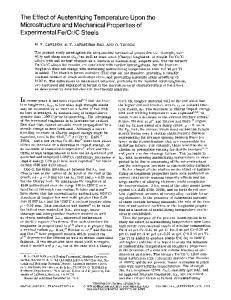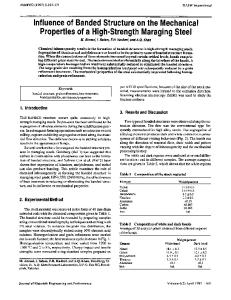Influence of Austenitizing Temperature on the Microstructure and Mechanical Properties of an Fe-Cr-Ni-Mo-Ti Maraging Sta
- PDF / 3,831,545 Bytes
- 10 Pages / 593.972 x 792 pts Page_size
- 53 Downloads / 389 Views
JMEPEG https://doi.org/10.1007/s11665-019-04279-6
Influence of Austenitizing Temperature on the Microstructure and Mechanical Properties of an Fe-Cr-Ni-Mo-Ti Maraging Stainless Steel Yong Lian, Minyu Ma, Jin Zhang, Jinfeng Huang, Wen Gao, Zunjun Zhang, and Chao Zhao (Submitted May 6, 2018; in revised form August 2, 2019) The influence of austenitizing temperature on the microstructure and mechanical properties of an Fe-Cr-NiMo-Ti maraging stainless steel was investigated. The grain size, Laves phase, and retained austenite in steels given different solution treatments were observed using optical microscopy, scanning electron microscopy, and x-ray diffraction. Relationships with mechanical properties were measured by tensile testing. The grain growth rate was relatively slow at temperatures of 800-1000 °C then rapidly increased at higher temperatures. Low-temperature austenitization augmented the retention of austenite, the fraction of which decreased with an increase in austenitizing temperature. The Laves phases, which precipitated in austenite during austenitization at 800-900 °C, were preserved after quenching. The solution treatment had a significant effect on the final tensile properties of the steel after aging, due to the presence of retained austenite and Laves phase reducing its strength. Keywords
austenitizing temperature, Laves phase, maraging stainless steel, retained austenite
1. Introduction Precipitation hardening is one of the most effective ways to obtain high-strength metallic materials (Ref 1-4). It is achieved by producing fine and dispersed precipitates that impede dislocation movement throughout the precipitation process. Age-hardenable maraging stainless steels have been widely used in the nuclear, chemical, aircraft, and naval industries. Maraging stainless steels are a type of high-performance steel that combines a martensite matrix with nanoprecipitates to achieve ultra-high-strength and good ductility (Ref 5, 6). The corrosion resistance of maraging stainless steels appears to be better than that of other standard martensitic counterparts and is similar to that of the common austenitic stainless steels found in most media (Ref 7, 8). The high strength and toughness of maraging stainless steels are obtained via a two-step quenching and aging process involving (1) austenitization to achieve a uniform austenite, followed by quenching to ambient temperature so as to generate a martensitic matrix structure, and (2) further aging at a temperature that enables precipitation in the lath martensite matrix (Ref 9). Many investigations of maraging stainless steels have focused on the precipitation behavior and effect of austenite reversion during the aging treatment (Ref 10Yong Lian, Minyu Ma, Jin Zhang, Wen Gao, and Chao Zhao, Institute for Advanced Materials and Technology, University of Science and Technology Beijing, Beijing 100083, China; and Jinfeng Huang and Zunjun Zhang, State Key Laboratory for Advanced Metals and Materials, University of Science and Technology Beijing, Beijing 100083, China.
Data Loading...











